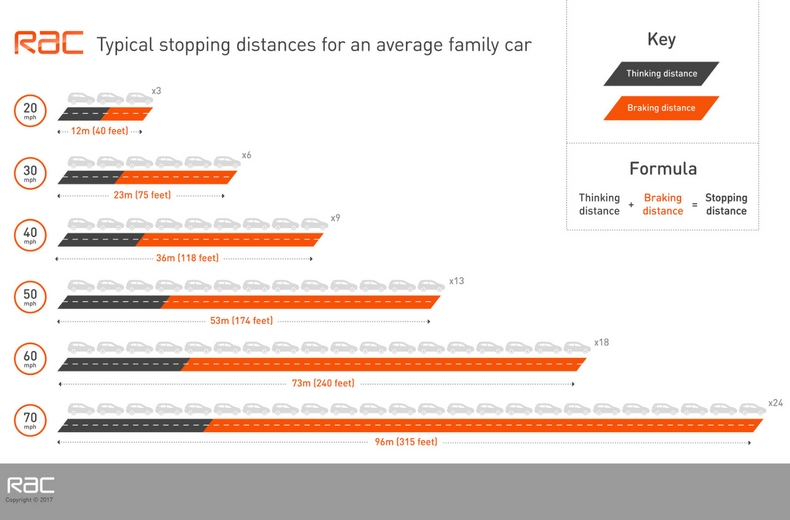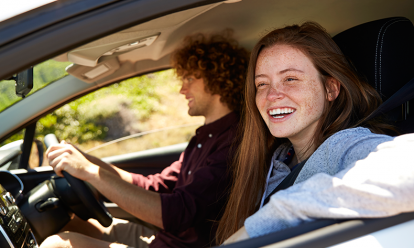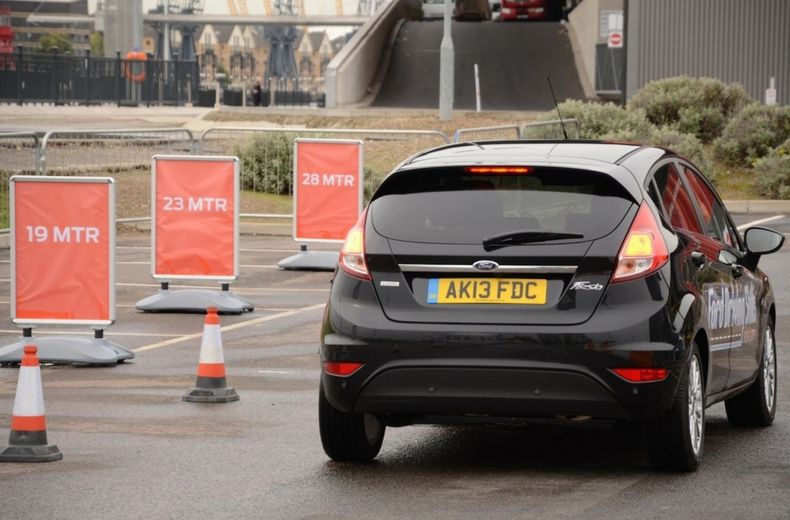Following too closely to other cars – or tailgating – is one of the biggest causes of road accidents in the UK and it could result in failing your driving test too.
Whether you're new to driving or have years of experience, knowing your stopping distances is a crucial part of staying safe on the roads, here we'll explain what they are, what affects them and how best to remember them.
Do you need help to pass your driving test? Find everything you need with the driving theory test app
What are average stopping distances?
It's first worth noting that a stopping distance = thinking distance + braking distance.
The following stopping distances relate to an average sized family car in normal weather conditions, however, it is also worth mentioning that a number of other factors can affect the stopping distance of a car (which we have outlined below).

Unsurprisingly, the faster a car is travelling, the longer it takes to stop.
Travelling at 40mph rather than 30mph means it’ll take an extra 13 metres (more than three car lengths) to come to a stop – think about that next time you consider breaking the 30mph speed limit.
Stopping distances are can be split into two main categories: the thinking distance and the braking distance.
- How to pass your driving test – a full guide from novice to pro
- 15 Driving test tips to help you pass first time
- Did you know that we offer specialist black box car insurance?
Learner Driver Car Insurance
Only pay for the cover you need until you’ve passed your test. Get learner driver insurance so you can practice outside of your lessons.


What is thinking distance?
Both categories are pretty self-explanatory. The ‘thinking distance’ is how long it takes for the driver to react to a hazard and apply the brake.
At higher speeds, the car will cover a greater distance while the driver realises he or she needs to brake to avoid a hazard. The Highway Code provides the following thinking distances at different speeds:
| Speed | Thinking distance (before reacting) |
|---|---|
| 20mph | 6 metres |
| 30mph | 9 metres |
| 40mph | 12 metres |
| 50mph | 15 metres |
| 60mph | 18 metres |
| 70mph | 21 metres |
At motorway speeds, you could cover the length of four cars before you even apply the brakes.
There are a number of factors that could affect a driver’s thinking distance. We’ll come onto those shortly.
What is braking distance?
The second part of the overall stopping distance is made up of the braking distance. This is how far your car travels while you’ve got your foot on the brake attempting to bring it to an emergency stop.
These are the official braking distances provided by the Highway Code:
| Speed | Braking distance |
|---|---|
| 20mph | 6 metres |
| 30mph | 14 metres |
| 40mph | 24 metres |
| 50mph | 38 metres |
| 60mph | 55 metres |
| 70mph | 75 metres |
At 20mph, the braking distance is exactly the same as the thinking distance. These combine to provide a total stopping distance of 12 metres.
At 70mph, the 75-metre braking distance makes up nearly 80% of the overall 96-metre stopping distance.
- The RAC's top fuel saving tips
- How much does it cost to learn to drive?
- Did you know that we offer specialist learner driver insurance?
Techniques to remember stopping distances
Stopping distances are a favourite part of the theory test, but they’re not easy to remember. That’s unless you know a special trick... which we’ll reveal here.
It takes a bit of maths, but bear with us. All you need to do is multiply the speed by intervals of 0.5, starting with 2. That’ll give you the stopping distance in feet, which is acceptable for the theory test. For example…
20mph x 2 = 40 feet
30mph x 2.5 = 75 feet
40mph x 3 = 120 feet
50mph x 3.5 = 175 feet
60mph x 4 = 240 feet
70mph x 4.5 = 315 feet
There are 3.3 feet in a metre – so divide the distance in feet by 3.3 to get the stopping distance in metres. You’ll need a calculator for that, but it shouldn’t be necessary for the theory test.
How to practise for your driving theory test
There are a number of different ways to practise for your driving theory test.
You can take free driving theory mock tests here on the official Government site.
You can also brush up on your road signs knowledge on our very own road signs quiz page.
As for apps, Driving Theory Test UK is a great place to start, with all necessary learning materials, hazard perception clips and Highway Code info included. You can download it here:
What other factors affect stopping distances?
As we’ve already mentioned, stopping distances can be influenced by a number of factors.
Some people suggest the stopping distances in the Highway Code are out of date because modern cars, with ABS systems and better tyres, can stop a lot quicker.
But remember, factors like this will only affect the braking distance. Unless the car’s fitted with an automatic emergency braking system, it won’t reduce the thinking time.
1. Weather
In poor weather conditions, a car’s total stopping distance is likely to be longer for a number of reasons. For a start, poor visibility might mean the driver takes longer to react – increasing his/her thinking distance. But slippery roads caused by rain, snow or ice will also extend the braking distance.
The Highway Code states braking distances can be doubled in wet conditions – and multiplied by 10 on snow or ice. That means, in the snow, it could take you further than the length of seven football pitches to stop from 70mph.
For help tackling the conditions check out our winter driving guide.
2. Road condition
It’s not always as obvious as ‘bad weather equals long stopping distances’, either. A road might be particularly greasy if there has been rain after a period of hot weather, or if oil has been spilt on it.
Be prepared for black ice on cold days, and watch out for loose surfaces such as gravel. All these could make it difficult to stop in a hurry.
- How to drive an automatic car
- UK road markings: what they mean and what the Highway Code says
- Blind spots – how, when and why it's vital to check it
3. Driver condition
While all these factors can affect the braking distance, the individual behind the wheel is responsible for the thinking distance – and that can have a huge effect on the overall stopping distance.
A driver’s age, how awake they are and if they’ve consumed any drugs or alcohol can all influence how quickly it takes them to react.
Using a mobile phone rather than concentrating on the road can have devastating effects on a driver’s stopping distance – just a few seconds glancing at your phone can add an football pitch to your overall stopping distance at motorway speeds. If the traffic ahead has stopped, that could ruin your day very quickly.
Other distractions in the car – such as loud music and passengers – can also affect the thinking time before you apply the brakes.
4. Car condition
While many modern cars may indeed be able to stop in shorter distances than the official Highway Code states, a car’s condition can also have an impact.
For example, cars equipped with budget tyres can take an extra 14 metres to stop from 70mph in wet conditions compared to cars with ‘premium brand’ tyres, or five metres in the dry.
Research has also found that tyres on the legal limit of 1.6mm tread can need an extra 60% more road to stop compared to brand new tyres.
Under-inflated tyres will also have an impact on stopping distances, as will cars with poorly maintained brakes.
Click here to find out more about the importance of tyre health and a video on how to health check your tyres.
Check your brake pads to make sure they have plenty of life left in them, and test your brakes after driving through water to check for moisture left between the pads and discs. Brake pads can be replaced, or you can go to a garage if they need a repair.
For more on brake pads read our definitive guide to looking after your brake pads
Can my stopping distances affect my car insurance premium?
Indirectly yes. If you take out a black box car insurance policy it monitors how safely you drive. For example, information on your braking is collected. That data is then used to update your premium when you come to renew your insurance. If you’re deemed as less of a risk i.e. you have good braking habits, you could pay less.
For complete peace of mind at home and at the roadside, purchase RAC Breakdown Cover today.
Black Box Insurance
Want to pay less for your car insurance? Whether you’re a new driver or just looking to reduce costs, we can help.


Services we offer
- Breakdown Cover
- European Breakdown Cover
- Motorbike Breakdown Cover
- Electric Car Breakdown Cover
- Caravan, Motorhome and Campervan Breakdown Cover
- Business Breakdown Cover
- Van Breakdown Cover
- RAC Approved Garages
- Vehicle servicing
- Vehicle repair
- MOTs
- Mobile mechanics
- RAC Tyres
- RAC Approved Dealers
- RAC Shop
- myRAC app
Stopping distances - FAQs
- What is the braking distance at 30mph?
The braking distance at 30 mph depends on a variety of factors, such as the road conditions, the type of vehicle, and the driver’s reaction time. Generally speaking, the braking distance for a typical passenger car on a dry road can start from 14 metres. This is why it is important to leave a safe following distance between you and the car in front of you, so that you have enough time and space to brake in time if necessary.
- What is a braking distance in driving?
The braking distance is the total distance a vehicle travels from the moment the brake pedal is pressed until the vehicle comes to a complete stop. It is calculated by taking into account the vehicle’s initial speed, the driver’s reaction time, and the vehicle’s braking capability.
- What is the braking distance formula?
All you need to do is multiply the speed by intervals of 0.5, starting with 2. That’ll give you the stopping distance in feet. For example…
- 20mph x 2 = 40 feet
- 30mph x 2.5 = 75 feet
- 40mph x 3 = 120 feet
- 50mph x 3.5 = 175 feet
- 60mph x 4 = 240 feet
- 70mph x 4.5 = 315 feet
There are 3.3 feet in a metre – so divide the distance in feet by 3.3 to get the stopping distance in metres.
- How do you remember stopping distances?
All you need to do is multiply the speed by intervals of 0.5, starting with 2. That’ll give you the stopping distance in feet. Divide the distance in feet by 3.3 to get the stopping distance in metres.
- How much does your stopping distance increase in rain?
According to the Government, it will at least double the stopping distance when compared to braking in dry conditions. Rule 227 of the Highway Code states this and that drivers should react accordingly.
- What is meant by thinking distance?
In short, this is the time it takes to react to a hazard or obstruction in the road when driving. The time taken to take the necessary action impacts the total stopping distances, etc.
- What are the stopping distances in the Highway Code?
Below are the official figures from the UK Government:
- 20mph x 2 = 40 feet
- 30mph x 2.5 = 75 feet
- 40mph x 3 = 120 feet
- 50mph x 3.5 = 175 feet
- 60mph x 4 = 240 feet
- 70mph x 4.5 = 315 feet
Divide the distance in feet by 3.3 to get the stopping distance in metres.
- What is the stopping distance for 20 mph?
The stopping distance when driving at 20mph in the dry, is about 40 feet or 14 metres.















